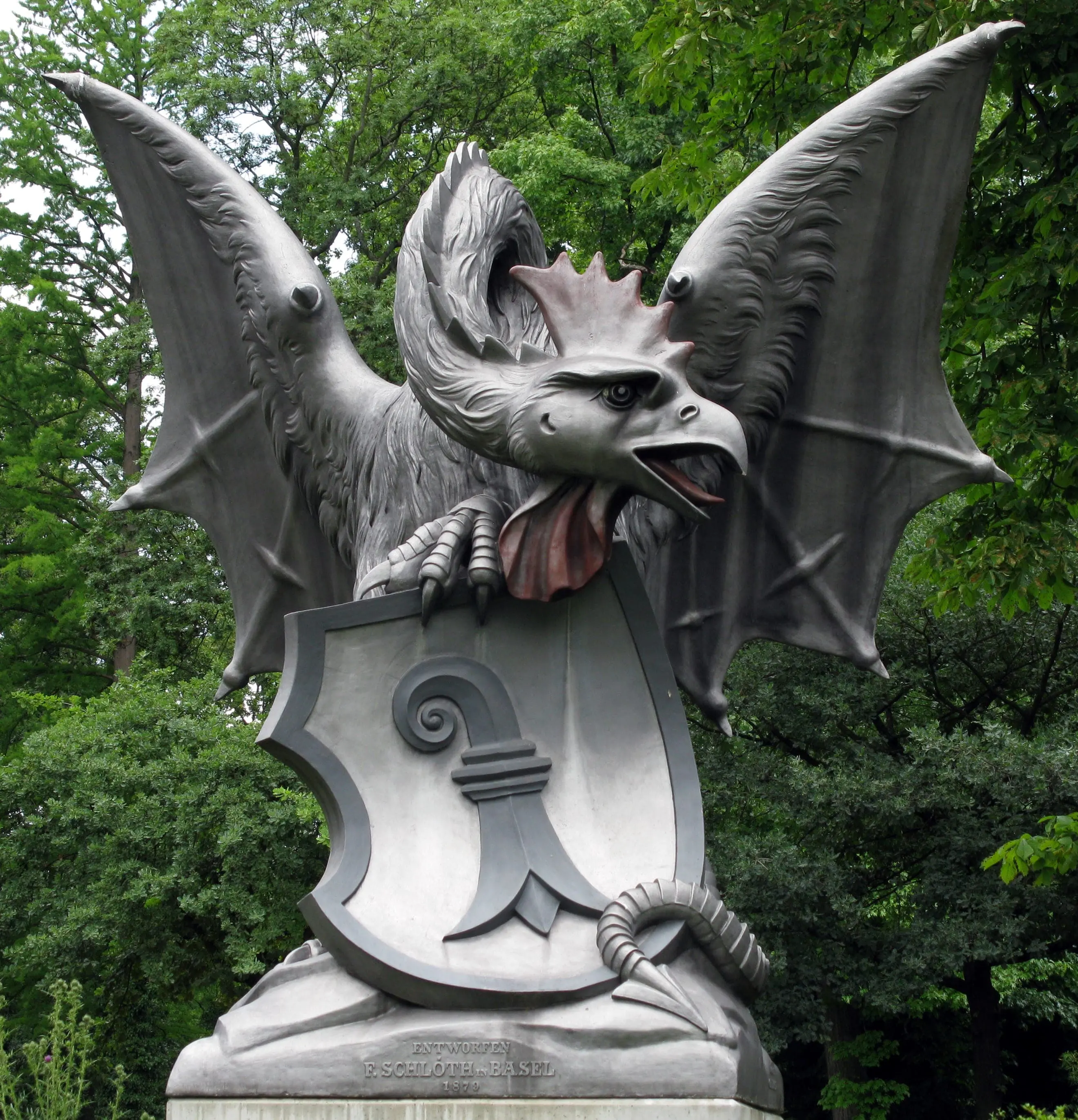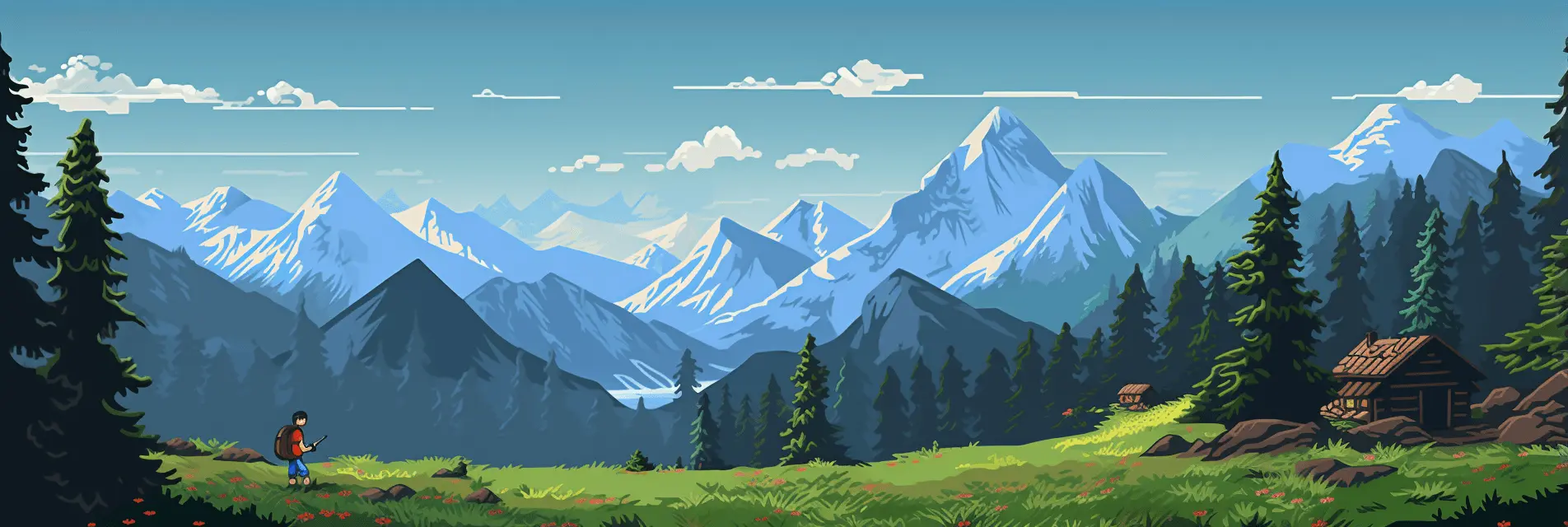Swiss Book of Legends: Based on oral traditions, chronicles, and other printed and handwritten sources
by C. Kohlrusch
Leipzig 1854.
The Basilisk Egg
In 1474, on the Thursday before Laurentii1, a rooster and an egg it had laid were burned on Kohliberg2 in Basel, where the free people lived and the free boys held court. This happened as a result of a judicial decision by the free boys3 and in the presence of a large crowd from the city and the countryside. The event caused considerable alarm because it was widely believed that such a rooster’s egg, if laid by a seven-year-old rooster and incubated in manure by a snake known as Coluber4—some also say mere sunlight suffices—would give birth to a Basilisk. This creature, half rooster and half snake, though no larger than a few spans in length, is more terrifying than the largest dragon, as its mere gaze is deadly. Such fearsome powers, however, are effective only in sunlight. Hence, people who had such a creature in their cellar had to keep it closed all year long to prevent sunlight from entering. It is also said that any bush or grass the Basilisk passes over immediately withers. The most frightening attribute is its deadly poison; if someone on horseback pierces the Basilisk with a lance, the poison travels up the lance and instantly kills both horse and rider. The only way to kill a Basilisk is to show it its own reflection; upon seeing it, the creature falls dead instantly.
Alpine Legends - Folk Traditions from Switzerland, from Vorarlberg, Carinthia, Styria, Salzburg, Upper and Lower Austria
by Theodor Vernaleken Vienna 1858
The Basilisk
According to the Basel legend, the Basilisk (Baselist) is the offspring of the mating between a rooster and a snake. It is in the coat of arms of the canton of Basel. In 1474, a sentence was passed by the Senate of Basel5, in which a rooster was condemned to be burned as a witch because it had laid an egg. This egg was also thrown into the fire.
The Basilisk of Basel
A story adapted by Verena Jenny from a story by Trudi Gerster
The Basilisk of Basel
In ancient times, many dragons lived all over the world. Some were good-natured, eating only plants, fruits, and roots and harming no one.
But there were also dangerous dragons and poisonous wyverns. They kidnapped beautiful maidens and dragged them into their caves, spewed fire, ate everything they could catch, and devastated entire countries. One of the most dangerous dragons was the Basilisk. He was not very large but was a gruesome monster. He had a rooster’s comb on his head. His body was that of a winged dragon and had a long, snake-like tail. His thick, powerful hind legs had sharp, curved claws. The Basilisk could run faster than any other animal on these strong hind legs. He also darted over ponds and streams without sinking. His breath was so poisonous that all plants in his vicinity withered. His piercing evil gaze killed anyone who looked into his eyes. These ghostly creatures hatched from black eggs, laid by black roosters and incubated in snake and toad dung.
Anyone who owned a black rooster had to be very careful.
Not far from Basel, in the area of today’s Allschwiler Forest6, lived such a terrible, eerie Basilisk.
Hunters, berry pickers, mushroom gatherers, and hikers were repeatedly found dead in the forest, and no one knew how they had died. Fear and sorrow reigned in the land.
One day, an old woman discovered the dangerous Basilisk while mushroom picking. She was watching a hare sniffing around the entrance of a burrow when suddenly the dragon shot out of the hole. He looked into the hare’s eyes with his deadly gaze. Struck down like by a lightning bolt, the poor animal fell over and was dead. The old woman told everyone what she had seen. It was decided to catch and kill the murderous monster.
At that time, two brave brothers named Wunibald7and Wenzeslaus8 lived in a small farming village near the Allschwiler Forest. They decided to neutralize the Basilisk. It was a difficult and dangerous task.
First, Wenzeslaus threw a net over the burrow. But the Basilisk tore the net apart with his sharp claws. Then Wunibald blocked the entrance of the cave with soil and moss. But as soon as the sun rose, the brothers saw from their hiding place how the dragon emerged from his hideout with a moss cap. The brothers discussed among themselves.
“We have to brick up the hole,” said Wenzeslaus.
So they set to work. It was hard work. Back then, there was no cement and no construction machines. Wenzeslaus and Wunibald had to build a kind of furnace and heat limestone over a strong fire until it could be crushed to dust. They mixed this limestone dust with water, bricked up the hole, and waited for the lime to harden completely. They sighed in relief.
“Now the poisonous guy can stay in there forever.” But just a few days later, a mushroom man was found dead in the forest again. The Basilisk had simply dug a new exit. Wunibald and Wenzeslaus did not give up. They hardly slept anymore, debated back and forth, and pondered day and night how they could get rid of the monster. Once, in the middle of the night, Wenzeslaus jumped out of bed, shook his brother awake, and shouted, “I’ve got it - we need a mirror!”
So the two went to a glassmaker early in the morning and ordered a large mirror. They carried it into the forest, placed it in front of the Basilisk’s new burrow, and hid behind a huge oak tree. They waited many hours. Finally, they heard a scraping, scratching, and snorting - the Basilisk climbed out of his burrow, stood upright on his thick hind legs in front of the mirror - looked himself in the piercing eyes, fell over, and was dead as a doornail.
The land was now freed from the dangerous Basilisk. Everyone was happy and celebrated a big feast. Today we can walk around the Allschwiler Forest again without worries. Basilisks only exist as fountain figures and as Basel’s heraldic animals. Of course, they are not dangerous, and as fountain figures, they even look quite pretty.
As noted by: T. Tschopp
General Information
- Title: The Rooster and the Basilisk Egg of 1474
- Location: Kohliberg, Basel, Switzerland
- Time: 1474, on the Thursday before the Feast of St. Lawrence (Laurentii) (August 10th)
- Main Characters: A rooster, the Free Boys (Freiknaben), a large crowd of people
- Central Element: The egg laid by a rooster, which could give birth to a basilisk
Plot Points
- Inciting Incident: A rooster lays an egg, causing alarm among the community.
- Judicial Involvement: Free Boys hold a court and decide to burn the rooster and the egg.
- Public Event: The burning takes place in the presence of a large crowd from both the city and countryside.
- Community Beliefs: A seven-year-old rooster’s egg, incubated by a snake known as Coluber or by sunlight, can give birth to a basilisk.
Beliefs about the Basilisk
- Physical Characteristics: Half rooster, half snake
- Size: Small (only a few spans in length)
- Powers:
- Deadly gaze
- Powers only effective in sunlight
- Causes vegetation to wither
- Deadly poison that can even travel through a lance
- Weakness: Dies instantly upon seeing its own reflection
Cultural Context
- August Is an interesting time for the event to take place. Things are normally born in the spring. This is almost at harvest time.
- Gender Bending Is this a reference to paganism or a reference to satanism in the form of inversion. Interesting that religion pays no part in this telling.
- Animal Trials The fact that a rooster and its egg were subjects of a legal proceeding is unusual. Typically, animals aren’t brought to trial, but the tale reflects medieval beliefs that even animals could be held accountable for disrupting social or natural order.
- Community Involvement: A large crowd gathered for the event, indicating it was of considerable public interest.
- Role of Free Boys: Act as judicial authority, pass judgment on the rooster and the egg.
- Widespread Fear: The community holds strong beliefs in the legend of the basilisk, affecting public sentiment and actions.
- St. Lawrence: Does this Saint have anything to do with the creature, the rooster, or the snake?
- Safety Measures: People who find such a creature keep their cellars closed all year to prevent sunlight from entering. Is this about shaming someone or encouraging them to keep their cellars clean and visitable.
-
St. Lawrence (or Laurentius in Latin) was a Christian martyr and one of the seven deacons of Rome who were responsible for giving help to the poor and the needy. He lived during the time of Emperor Valerian, around the 3rd century AD. During the persecution of Christians, Lawrence was ordered to bring the treasures of the Church to the Roman authorities. Instead, he presented the poor and the sick, declaring them to be the true treasures of the Church. For this act, he was reportedly martyred by being roasted alive on a gridiron. St. Lawrence is considered the patron saint of cooks, chefs, and comedians, among others, and his emblem is often the gridiron on which he was said to have been martyred. His feast day is observed on August 10th each year. This day is commonly referred to as the Feast of St. Lawrence. Given that the Swiss folktale you mentioned refers to the “Thursday before Laurentii,” it would be the Thursday immediately preceding August 10th. ↩
-
A well-known geographical location in Basel, Switzerland. In the context of the story, it appears to be a place where “free people” lived and where “free boys held court.” The story suggests that it’s a place significant enough to serve as the venue for the dramatic events involving the burning of the rooster and its egg, which were suspected of leading to the birth of a basilisk. The name “Kohliberg” itself does not appear to be widely recognized as a specific mountain, hill, or area in Basel or its surrounding regions . It’s possible that the name could be a fictional or historical locale used for the purpose of storytelling. ↩
-
The term “Freiknaben” (translated as “free boys”) appears in the Swiss German folktale “Das Basilisken-Ei.” In the context of the story, it suggests a group of young men or boys who hold some form of judicial or decision-making power. They are the ones who pass the judgment leading to the burning of the rooster and its egg due to the fear of a basilisk being born. The term “Freiknaben” is not a standard or widely recognized term in Swiss or German history, law, or folklore. Its specific meaning could be unique to this tale or may be a poetic or symbolic way to describe a group of individuals who held communal or judicial roles in the local society. Given its specialized context in the story, it would be reasonable to explain in your post that the “free boys” were a form of local authority or decision-making body within the community, even though the exact details of their role or functions may not be clearly defined. ↩
-
The term “Coluber” refers to a genus of snakes, generally known for being non-venomous, quick, and agile. In classical Latin and historical texts, the word “coluber” has been used more broadly to describe snakes. The genus Coluber includes species like the racer snakes in North America, which are known for their speed and agility. In the context of “Das Basilisken-Ei,” the term “Coluber” is mentioned as the type of snake that is believed to incubate the rooster’s egg to give birth to a basilisk when the egg is laid by a seven-year-old rooster. The choice of the term may be based on older, more generalized use of the word to mean “snake,” rather than referring to the specific genus of Coluber. The mention of a snake in the story likely draws on the creature’s historical and symbolic associations with danger, transformation, and mystery, contributing to the tale’s sense of foreboding and the miraculous. ↩
-
In 1474, Basel was a part of the Old Swiss Confederation, and like other medieval Swiss cities, it had a complex system of governance. The term “Senate” in this context likely refers to the council or assembly that governed the city. The governing council would have consisted of influential citizens, often from elite families, and they were responsible for making laws, administering justice, and governing the city’s affairs. During this period, Basel was a bustling commercial and cultural center. It was strategically located on the Rhine River, facilitating trade, and its university, founded in 1460, was one of the leading educational institutions in Europe. The 1470s were a period of considerable social and political upheaval throughout Europe. The Inquisition was ongoing, and there was a heightened focus on eradicating heresy and witchcraft, which could explain the unusual judicial proceedings against a rooster for laying an egg. It’s worth noting that these kinds of trials were not entirely unheard of; there are instances in medieval Europe where animals were put on trial, usually for acts considered supernatural or heretical. However, it should also be remembered that the story of the basilisk and the rooster’s trial may be a legend or folklore rather than a strictly historical account. Still, the tale does provide an intriguing look at the superstitions and legal practices of the time. ↩
-
The Allschwiler Wald (Allschwiler Forest) is located near Basel, in Switzerland, close to the border with France and Germany. It is a popular area for outdoor activities like walking, cycling, and wildlife observation. The forest is also a significant green space that serves as a recreational area for the residents of Basel and nearby regions. As for stories and folklore related to the Allschwiler Wald, while the tale of the Basilisk is one of the more famous ones, the forest, like many old forests in Europe, has been the subject of various local legends and tales. These can include ghost stories, legends of hidden treasures, and tales of historical events that allegedly took place in the forest. However, the specifics can vary and might be best explored through local storytelling traditions or historical archives. It’s worth noting that forests often play significant roles in European folklore, serving as settings for various myths, legends, and fairy tales. The Allschwiler Wald, given its age and prominence in the local landscape, is no exception. ↩
-
The name “Wunibald” is of Germanic origin and is relatively uncommon. It is composed of two elements: “wunni,” which means “desire” or “wish,” and “bald,” which means “bold” or “brave.” Therefore, the name could be interpreted to mean “desirous and bold” or “wishing to be brave.” The name is historically significant in the Christian context as well. Saint Wunibald was a 8th-century Anglo-Saxon missionary who was a member of the Hiberno-Scottish mission, which aimed to convert parts of Germany and the Frankish Empire to Christianity. It’s worth noting that names can carry different connotations and meanings in different cultures or contexts, so the interpretation of the name might vary. ↩
-
The name “Wenzeslaus” is a variation of “Wenceslaus,” which is of Slavic origin. The original Slavic form of the name is “Vyacheslav,” which is composed of two elements: “vyache,” meaning “greater,” and “slav,” meaning “glory.” Therefore, the name can be interpreted to mean “greater glory” or “more glorious.” The name is perhaps most famously associated with Good King Wenceslaus, a historical Duke of Bohemia from the 10th century who is also a saint venerated in the Roman Catholic Church. The story of his charitable acts has been immortalized in the English Christmas carol “Good King Wenceslaus.” As with any name, its meaning can vary by culture and context, but generally, the name Wenzeslaus or Wenceslaus is associated with notions of greatness or glory. ↩



